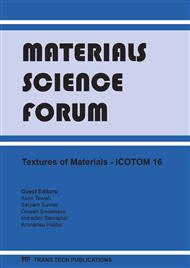p.52
p.56
p.60
p.64
p.68
p.76
p.80
p.85
p.89
Texture Control of Aluminum and Magnesium Alloys by the Symmetric/Asymmetric Combination Rolling Process
Abstract:
In order to develop favorable textures for deep drawing of Al-Mg-Si and Mg-Al-Zn alloys that are promising as automotive body panels, we have adopted the symmetric/asymmetric combination rolling (SACR) process consisting of conventional symmetric rolling and subsequent asymmetric rolling at relatively low reduction. The combination of symmetric cold rolling and asymmetric warm rolling for AA6022 sheets leads to the formation of “TD-rotated β-fiber texture”, resulting in the evolution of {111} recrystallization texture after solution treatment at a high temperature. The SACR processed and solution-treated sheets show a high average r-value with small in-plane anisotropy, and consequently the limiting drawing ratio increases significantly, compared to that of the cold-rolled and solution-treated sheets. In the case of AZ31 magnesium alloy, the SACR process by hot rolling causes the formation of a unique texture, which shows two (0001) poles with tilt angles of 0 and −40 degrees from the normal direction (ND) toward the rolling direction (RD). In addition, subsequent annealing weakens intensity of the double-peak texture, so that the drawability is greatly improved in comparison with that of the conventional warm-rolled sheets with a strong basal texture. At the same time, yield strength decreases to some extent, but the SACR processed and annealed sheets exhibit a good balance of strength and formability due to a mixed texture with basal and tilt components.
Info:
Periodical:
Pages:
68-75
Citation:
Online since:
December 2011
Authors:
Price:
Сopyright:
© 2012 Trans Tech Publications Ltd. All Rights Reserved
Share:
Citation:


